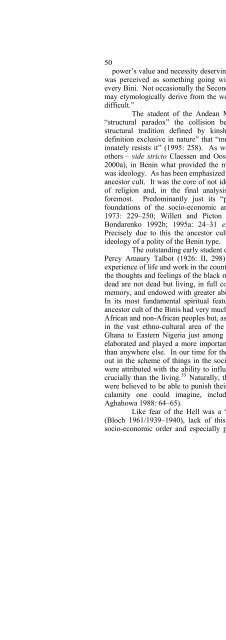Bondarenko Dmitri M. Homoarchy
Bondarenko Dmitri M. Homoarchy
Bondarenko Dmitri M. Homoarchy
You also want an ePaper? Increase the reach of your titles
YUMPU automatically turns print PDFs into web optimized ePapers that Google loves.
50<br />
power’s value and necessity deserving a corresponding attitude to its holders<br />
was perceived as something going without saying and vitally important for<br />
every Bini. Not occasionally the Second dynasty supreme ruler’s title, the Oba,<br />
may etymologically derive from the word ooba that can be translated as “it is<br />
difficult.”<br />
The student of the Andean Moche culture Bawden has defined as<br />
“structural paradox” the collision between social order “embedded in a<br />
structural tradition defined by kinship principles” and “elite power, by<br />
definition exclusive in nature” that “must be constructed within a context that<br />
innately resists it” (1995: 258). As well as in the Moche culture (and many<br />
others – vide stricto Claessen and Oosten 1996a; <strong>Bondarenko</strong> and Korotayev<br />
2000a), in Benin what provided the means for overcoming the contradiction<br />
was ideology. As has been emphasized above, the core of this ideology was the<br />
ancestor cult. It was the core of not ideology as a political construct only, but<br />
of religion and, in the final analysis, the Binis’ world outlook first and<br />
foremost. Predominantly just its “philosophy” and morality formed the<br />
foundations of the socio-economic and political relations (Bradbury 1965;<br />
1973: 229–250; Willett and Picton 1967; Dean 1983; Aghahowa 1988;<br />
<strong>Bondarenko</strong> 1992b; 1995a: 24–31 et al.; 1996b; 1997a; 1997b; 2000a).<br />
Precisely due to this the ancestor cult could be so effectively employed in<br />
ideology of a polity of the Benin type.<br />
The outstanding early student of Nigerian peoples, including the Binis,<br />
Percy Amaury Talbot (1926: II, 298) emphasized basing on his many-year<br />
experience of life and work in the country that “[n]o one can hope to appreciate<br />
the thoughts and feelings of the black man who does not realise that to him the<br />
dead are not dead but living, in full command of all their faculties, including<br />
memory, and endowed with greater abilities and powers than when on earth”.<br />
In its most fundamental spiritual features and their reflections in rituals the<br />
ancestor cult of the Binis had very much in common with the same cult of other<br />
African and non-African peoples but, as Parrinder (1978: 124–125) pointed out,<br />
in the vast ethno-cultural area of the coastal tropical forest extending from<br />
Ghana to Eastern Nigeria just among the Binis it was especially profoundly<br />
elaborated and played a more important part in private and socio-political life<br />
than anywhere else. In our time for the Binis ancestors still “… are never left<br />
out in the scheme of things in the society” (Aghahowa 1988: 63). Ancestors<br />
were attributed with the ability to influence social life even more actively and<br />
crucially than the living. 33 Naturally, the spirits demanded constant care: they<br />
were believed to be able to punish their improperly behaving offspring by any<br />
calamity one could imagine, including even death (Emowon 1984: 8;<br />
Aghahowa 1988: 64–65).<br />
Like fear of the Hell was a “great social fact” in medieval Europe<br />
(Bloch 1961/1939–1940), lack of this fear in Benin influenced directly her<br />
socio-economic order and especially political culture and system. An early







